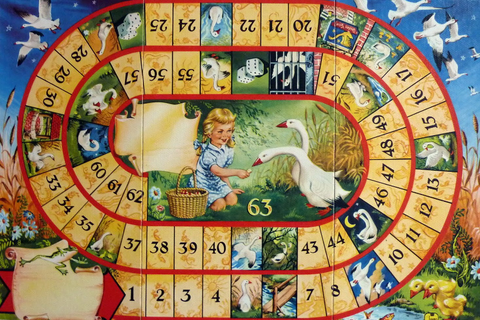Simulation: Game of Goose
From Gender and Tech Resources
The oldest spiral Game of Life we know, Mehen [1], was reported found in Egyptian Old Kingdom graves dating as far back as 5000 BP. This form of game seems to have spread over Europe in the 16th century.
Spiral games of life seem to have in common that they have 63 (7 times 9) fields, obstacles and surprises are placed at 6, 19, 31, 42, 52 and 58, and the spiral goes inward counterclockwise, mirroring the possible dangers, coincidences, happy occasions, progress, hitches and certain death affecting human life (and our contextually non fitting opinions, assumptions, belief systems, and world views, whole cultures, species, planets, stars, ... in short, systems.
The rules of this Game of Goose version have been changed to get rid of limiting beliefs about our capacity to work together.
- Duration: 3 hours
- Type: Experiential learning cycle
- Minimum number of participants: 10
- Maximum number of participants: 60 – 120 (depending on number of facilitators available)
Contents
Licensing
Copycenter 2015 Anonymous - CC0 1.0 Universal Public Domain Dedication: If you wish to facilitate it, feel free to do so. Also feel free to adopt/adapt/use in *any* way you wish/want/need.
The (changed) rules of Game of Goose
Purpose
The team conquering all obstacles and reaching the target field 63 exactly with all pawns, has won.
Resources & start condition
- Every player receives a budget of 5 counters/sweets.
- All pawns of a team are placed before field 1, for that is life's order.
General rules
- The youngest team member may begin.
- In clockwise turn the dice are thrown by the players. Players move a goose pawn as many fields on the game board as the total number on the dice.
- A pawn may not be placed on a field already taken by another pawn.
Exceptional rules
- If a player throws 5 and 4 in his or her first throw, a pawn may be moved to field 53 immediately.
- If a first throw is 2 and 6, a pawn can be chosen to move to 26 immediately.
Operational rules
- Number 6 is the Bridge leading to the target field faster: Payment of 5 sweets gets your pawn across and advances you to field 12. Without payment you are using a toll free bridge, the long road. Pass over a turn for throwing the dice.
- 19 is the Inn. 5 counters must be paid for keep, or you collapse and need to recoup for two turns.
- 31 is the Well. This costs you all your counters and you’ll have to wait until someone comes to rescue you. And of course, if that happens your savior drops in the well while saving you.
- 42 is the Labyrinth. Pay 5 counters and go back to number 37.
- 52 is Prison. Wait until one of your accomplices frees you. Alas, your mate is apprehended whilst in the act of freeing you. He now goes to prison instead.
- 58 is Death. Start anew, at Number 1.
Facilitator guide
Purpose of game
This Game of Goose, an old Mehen board game, with its changed rules, is intended to create space for awareness of likely responses of a body (operational system) to given objectives and to strategic aim changes from the head (executive system). The rules have been adapted to serve collectives. And by association this game prepares the way for systems that wish to steer and anticipate change.
Embedded process
This game must be embedded in something like an experiential learning cycle, learning in which people do something – not just think about something. Minimally this cycle would be something like:
- Context setting: A short explanation on experiential learning and the game; request teams; provide board and rules. (ten minutes)
- Concrete experience: Playing the game (twenty minutes)
- Reflective observations: Asking the teams for what happened and their experiences (ten minutes)
- Generalizations about experiences: Tie-in with "real" world discussion (ten minutes)
The objective given to teams clearly states the whole team needs to get to the end of the obstacle course. So far nearly no teams figured out playing with non-existing individual rules by themselves. Facilitators may perhaps need to introduce this notion as transforming idea with respect to game timing and team energy pressures. Around ten minutes in the game I use sentences like “You seem to be playing against rules in your head”.
Suggested resources
- A room to play in, with enough tables and chairs
- Comfortable in light and temperature
- Feedback questions on paper
- The Rules Of The Game one-pager
- 1 Board of Goose per five players, with 5 pawns and two dice per board
- Enough Sweets/candy/GO stones (whatever you wish to play for)
- Flipchart with enough flip chart paper and pens
- Enough playful minds
- One extremely playful multi-team facilitator
Suggested feedback questions
- What were the key elements of the game for you?
- Which parts came through very clearly for you?
- Which parts were unclear?
- What did you like, or not like, about the game?
- Where did your team struggle most?
- Where did you have breakthroughs and/or new insights?
- Has the game been fun?
- Did it meet your expectations? If so, how has it met your expectations?
- How will you be applying what rule changes you made?
What follow up is likely to help you apply effectively what you have learned? Who else, do you think, could benefit from playing this game too?
